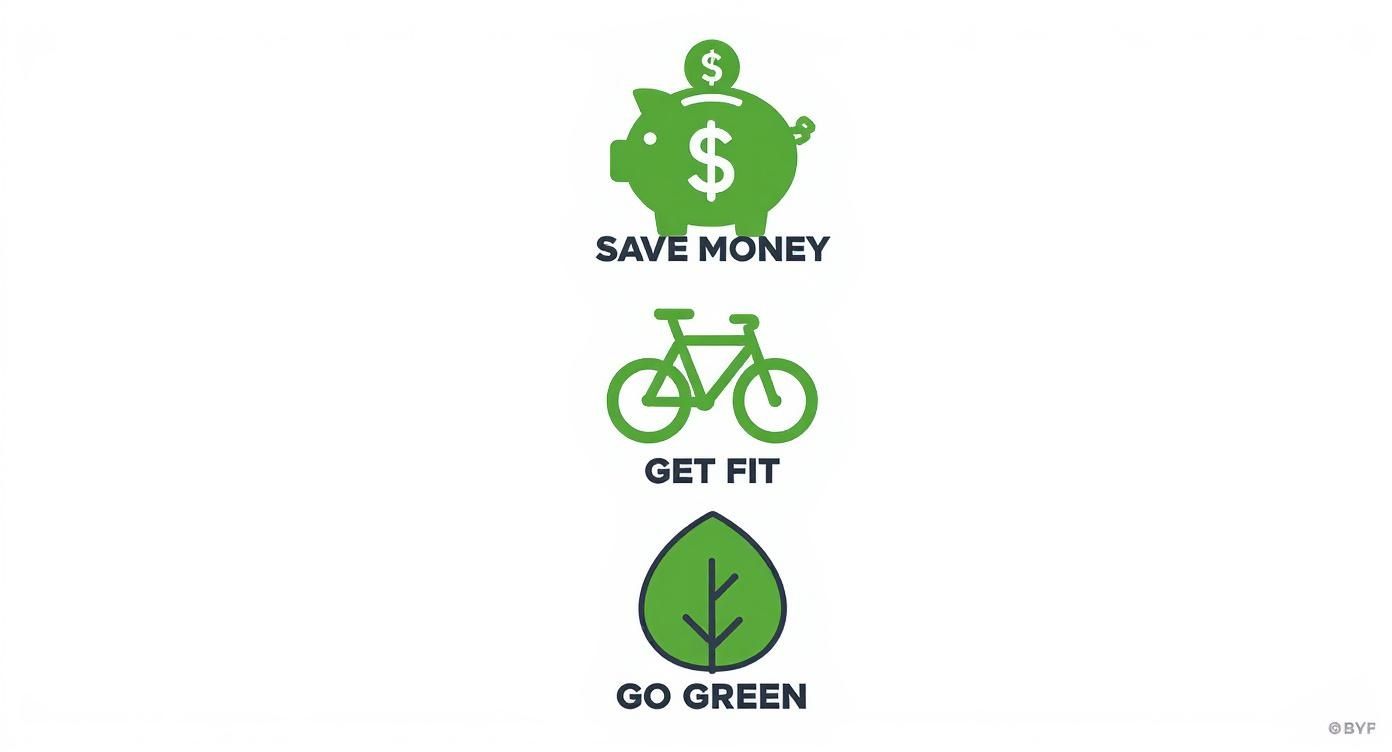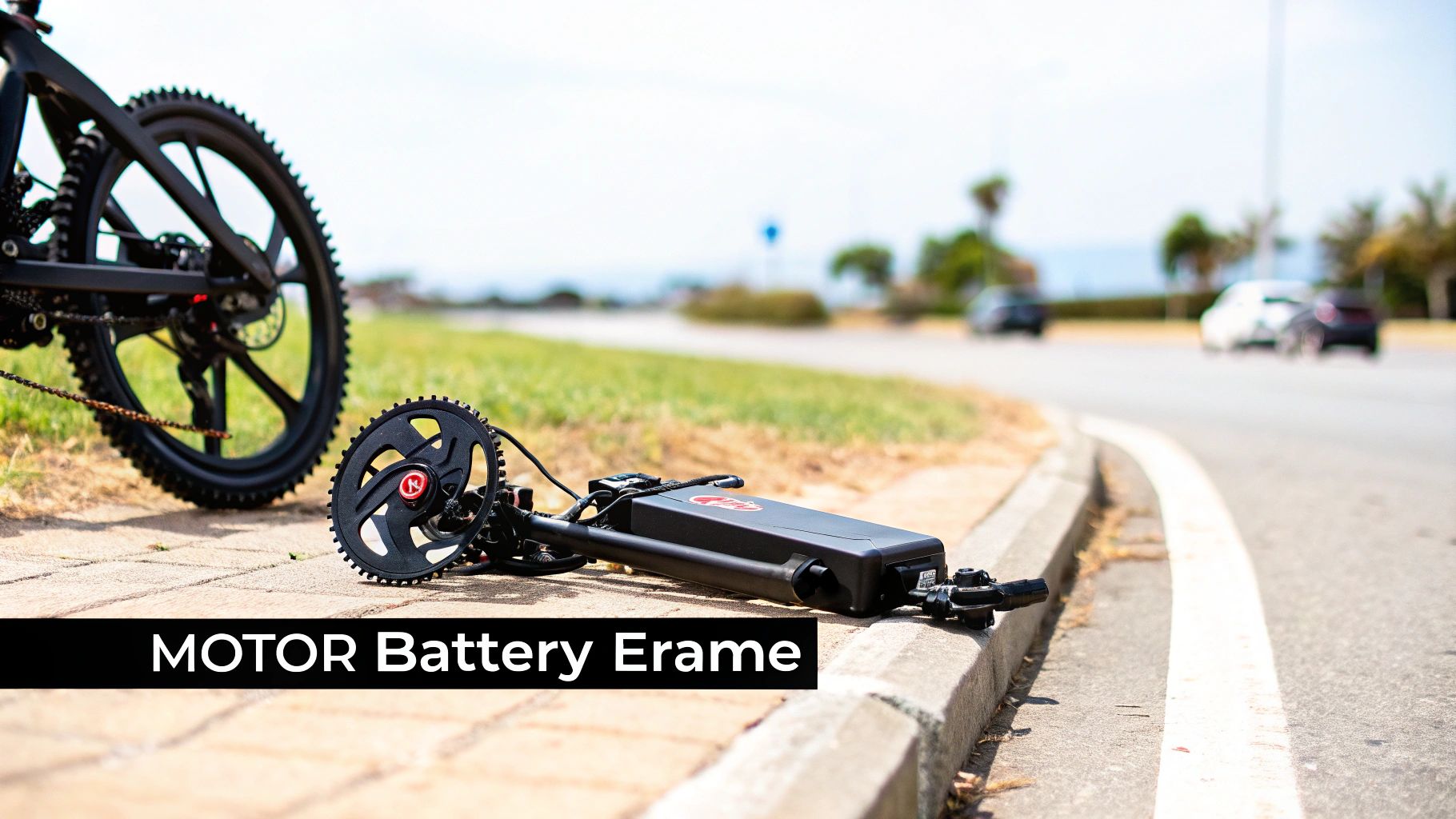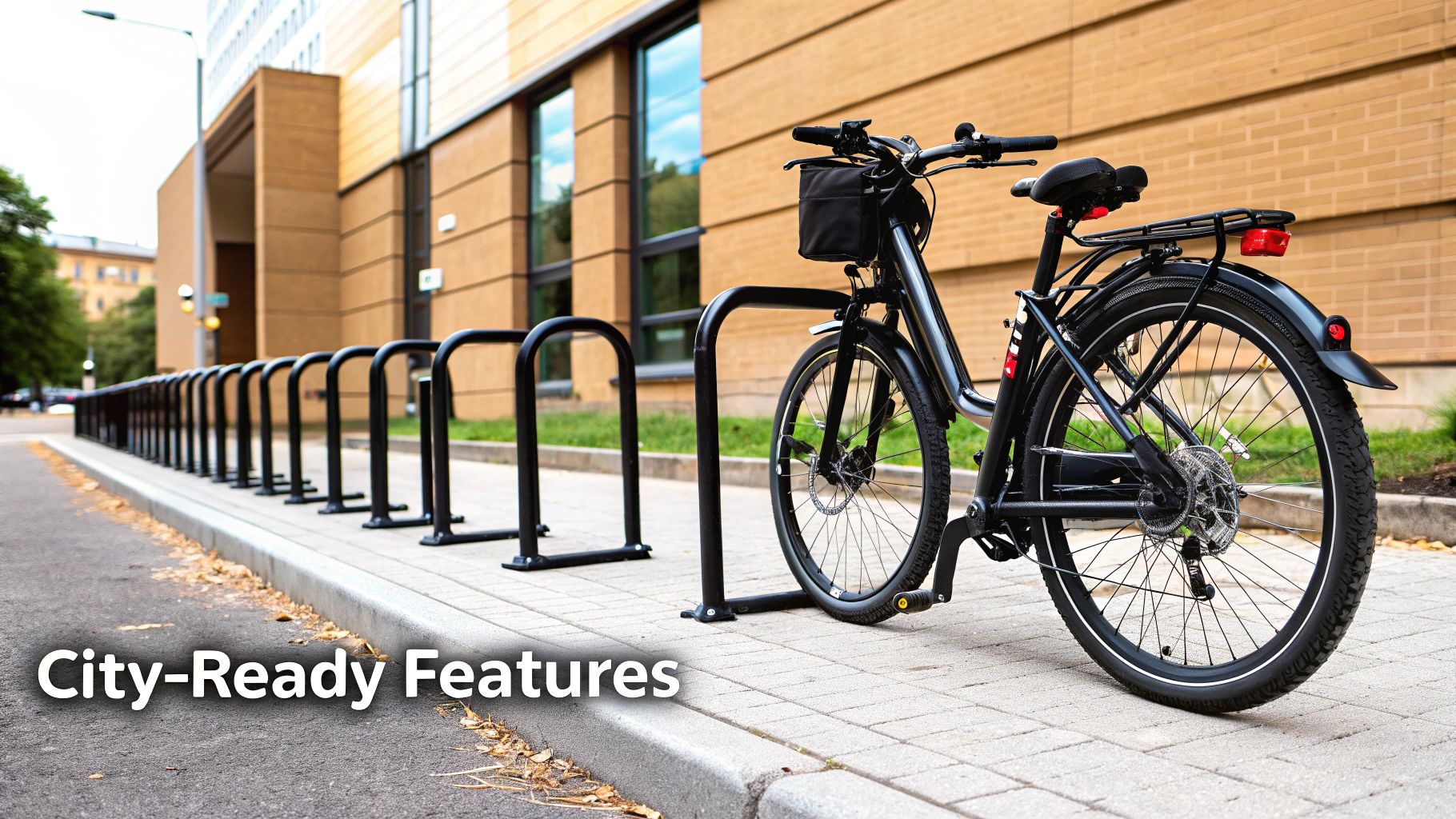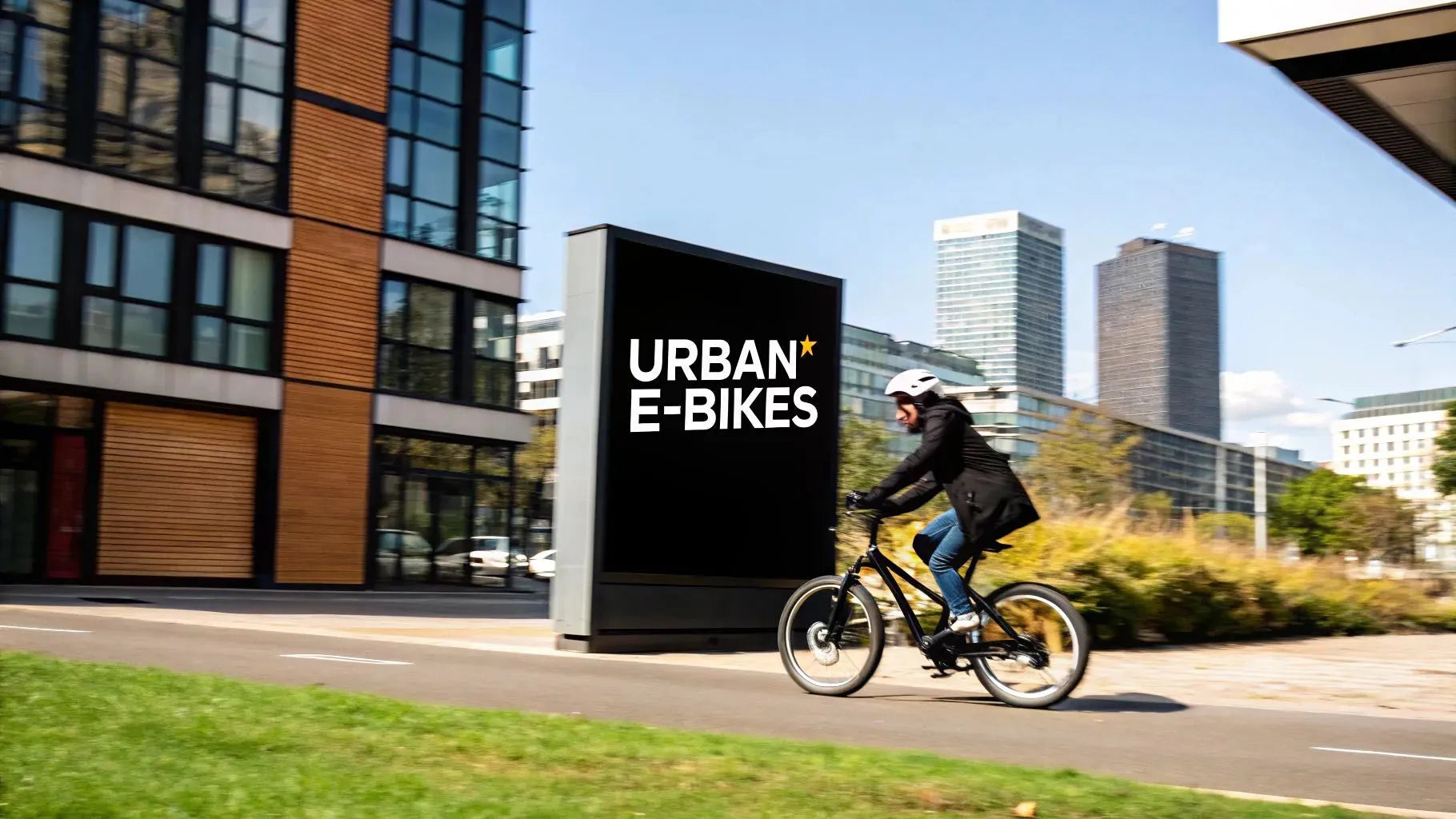Let's be real—the daily commute can be an absolute soul-crusher. Whether you're jammed in bumper-to-bumper traffic, crammed into a packed subway, or endlessly hunting for a parking spot, it often feels like the worst part of the day. It’s a frustrating cycle that drains your time, your wallet, and your will to live.
But what if you could just… skip all that? Imagine breezing past lines of stationary cars, feeling the wind in your hair, and actually enjoying the journey to work. This isn't some far-off dream; it's the daily reality for a fast-growing number of city dwellers who have discovered the power of an electric bike.
They aren't just a fun new toy. For urban commuting, they represent a whole new way of thinking about how we get around our cities.
Why E-Bikes Are Your New Commuting Superpower
Switching to an e-bike for your commute isn't just about changing your mode of transport; it’s about upgrading your entire lifestyle. It’s the secret to a smarter, healthier, and frankly, more enjoyable way to navigate the city.
Reclaim Your Time and Your Wallet
One of the first things you'll notice is the financial relief. Seriously, think about what it costs to run a car each month—gas, insurance, parking, and repairs all add up to a hefty bill. Daily public transport fares in major US and Australian cities aren't much better. An e-bike slashes those costs right away.
But even better than the money, you get back your most precious resource: time. With an e-bike, you can zip down dedicated bike lanes, take clever shortcuts, and completely avoid the traffic jams that plague drivers. That 30-minute car journey in rush hour? It can easily become a 15-20 minute ride on an e-bike, handing you back a chunk of your day, every single day.

As you can see, e-bikes deliver a powerful combo of saving money, boosting your health, and being kinder to the planet. It’s an all-around win for the modern city commuter.
Your Daily Commute Face-Off
Here's a quick look at how an e-bike stacks up against cars, public transport, and traditional bikes for the typical city commute.
| Commuting Method | Average Time in Traffic | Typical Monthly Cost (US/AU Focus) | Health Benefit | Environmental Impact |
|---|---|---|---|---|
| Electric Bike | Minimal to none | $10-$20 (charging & maintenance) | Moderate (active travel) | Very Low |
| Car | High | $300-$500+ (gas, insurance, parking) | None (sedentary) | High |
| Public Transport | Varies (often high) | $100-$250+ (monthly pass) | Low (walking to/from stops) | Medium |
| Traditional Bike | Minimal to none | ~$5 (maintenance) | High (full workout) | Very Low |
The numbers don't lie. For a balance of speed, cost-effectiveness, and health perks, the e-bike is tough to beat for urban journeys.
Effortless Fitness and a Greener Footprint
We all want to be more active, but finding the time is the hard part. An e-bike brilliantly solves this by weaving exercise right into your daily schedule. The electric assist is the game-changer here—it flattens hills and makes longer distances feel easy, so you don't have to be a hardcore cyclist to get started.
An e-bike commute turns a passive journey into an active one. You get all the good stuff—better heart health, less stress—without the intensity of a regular bike. That means you arrive at work feeling fresh and energized, not drenched in sweat.
This is a much more sustainable approach to fitness than that gym membership you keep meaning to use.
And while you're doing yourself a favour, you're also doing the planet one. Every trip on your e-bike is one less car clogging up the roads. That means:
- Less pollution and cleaner air for our cities.
- Reduced noise, making our streets quieter and more pleasant.
- Fewer traffic jams for everyone else.
The secret is out, and people are catching on fast. The global electric bike market is booming, with projections showing a massive annual growth rate of 13.06% between 2025 and 2029. The market is expected to hit a volume of around US$3.55 billion, driven almost entirely by people looking for a better way to commute.
If you're curious about whether it's the right move for you, you can explore our detailed guide on if electric bikes are worth it for your specific needs.
What Makes Your E-Bike Tick?
So, you're thinking about an e-bike. It might seem like there's a lot of tech involved, but it really boils down to three core components working together. Once you get a handle on the "big three"—the motor, the battery, and the frame—you'll know exactly what to look for.
Think of them as the heart, the lungs, and the skeleton of your ride. Each one plays a huge part in how the bike feels, how far it’ll take you, and how well it slots into your daily routine. Let's break it down without the jargon, so you can pick a commuting partner you'll genuinely love riding.

The Motor: Your Personal Tailwind
This is what puts the "e" in e-bike. It's that magic boost you feel, your own personal tailwind on demand. When it comes to electric bikes for urban commuting, you’ll generally run into two main types of motors, and they each have a distinct personality.
-
Hub-Drive Motors: You'll find these tucked into the hub of the front or rear wheel. They give you a feeling of being pushed or pulled along, which is awesome for cruising through mostly flat city streets. They also tend to be a bit easier on the wallet and require less maintenance, making them a solid, no-fuss choice.
-
Mid-Drive Motors: These are mounted right in the middle of the frame, where your pedals are. This setup puts power directly into the drivetrain, so it feels incredibly natural—almost like you suddenly have superhuman leg strength. They are masters of the hills because they use the bike's gears, giving them a serious edge for commutes with any kind of incline.
The difference between a hub and mid-drive motor is all about the feel. A hub motor is like a helpful shove from behind, while a mid-drive makes you feel like you've been secretly training for the Tour de France.
If your route has hills or you just want the most intuitive ride possible, it's really worth looking into mid-drives. To get the full scoop, check out our guide on finding the https://www.punkride.com/blogs/news-advice/best-mid-drive-electric-bike.
The Battery: Your Fuel Tank
If the motor is the engine, the battery is the fuel tank. Its capacity dictates your bike's range—how far you can go before you need to plug it in. This is where you'll see a number followed by "Wh," which stands for Watt-hours.
Don't get too hung up on the term. Just think of it this way: a bigger Wh number means a bigger fuel tank, which means more miles between charges. For most city commutes, a battery somewhere between 400Wh and 600Wh is the sweet spot. That's usually plenty of juice for a few days of riding.
Knowing your range just makes life easier. You can stop worrying about running out of power and have the freedom to take that scenic detour home or run a few errands after work. No more range anxiety.
The Frame: The Foundation of Your Ride
Finally, we have the frame. It's the skeleton of the whole operation and defines the bike's comfort, style, and day-to-day usability. The style you pick can make a surprisingly big difference.
| Frame Type | Best For | Key Advantage |
|---|---|---|
| Step-Through | Commuting in work clothes or skirts | So easy to hop on and off without a high bar. |
| Step-Over | A traditional, sporty ride | The classic diamond frame offers a stiffer, more responsive feel. |
| Folding | Commutes involving trains or buses | Folds down small for carrying and stashing away. |
A step-through frame is a lifesaver for city riders who don't want to deal with swinging a leg over the bike in their work clothes. On the other hand, a folding bike is a game-changer if your commute involves a mix of cycling and public transport. Some, like the 12.5kg ADO Air Carbon, are so light you can carry them up a flight of stairs without breaking a sweat—perfect for apartment life.
Picking the right frame ensures your e-bike isn't just a way to get around; it's a tool that fits perfectly into your life.
Finding the Perfect Features for Your City Ride

Sure, the motor and battery are the heart and soul of an e-bike, but it's the little things that really make it your perfect commuting partner. These are the details that count when you're out there on the daily grind, turning a good bike into a great one.
Think about your actual commute—it's not always a sunny, leisurely cruise, right? You're dealing with early mornings, late nights, dodgy weather, and lugging your stuff around. Nailing the right features from day one means your e-bike is ready for whatever the city decides to throw at you.
Let’s get into the non-negotiables that every urban e-bike should have. Consider this your checklist for finding a ride that’s truly built for the realities of city life.
Lighting the Way Safely
City riding often means you’re out before the sun’s up or heading home after it’s gone down. In those situations, a good set of lights isn't just a nice-to-have; it's a must-have for safety. The best electric bikes for urban commuting come with powerful lights built right in.
Integrated lights are wired directly into the main battery, so you never have to worry about them dying or remembering to charge them separately. They're just there, ready to go when you are, making sure you can see what's ahead and—more importantly—that everyone else can see you.
Essential Gear for All-Weather Riding
Let's be honest, city weather can be all over the place. A beautiful morning can easily become a drizzly afternoon, and that’s when a couple of simple features become your best friends. These aren't fancy extras; they're absolute workhorses.
-
Full-Length Mudguards: Hitting a puddle and getting that lovely muddy streak up your back is a terrible way to start a workday. Full-length mudguards (some people call them fenders) are brilliant for keeping all that road gunk off your clothes, so you arrive looking fresh.
-
Sturdy Rear Rack: Unless you enjoy showing up with a sweaty back from your backpack, a rear rack is a game-changer. It lets you clip on pannier bags to carry your laptop, groceries, or a change of clothes. This keeps the weight off your body, making the ride way more comfortable.
These two things are what make your e-bike a true year-round vehicle. They add a level of practicality that means you can count on your bike, rain or shine.
Mastering the Stop and Go with Superior Brakes
Urban riding is a constant dance of stopping and starting. You’re navigating traffic lights, pedestrians, and cars doing unpredictable things. In this environment, your brakes are just as important as your motor. This is where disc brakes really shine.
Disc brakes give you way more stopping power than old-school rim brakes, especially when it’s wet. When a car pulls out in front of you, that extra control can be the difference between a close call and a very bad day.
You'll generally see two types:
| Brake Type | How It Works | Best For |
|---|---|---|
| Mechanical Disc Brakes | A steel cable physically pulls the brake pads together. | Good, reliable performance that’s a huge step up from rim brakes, often found on more budget-friendly bikes. |
| Hydraulic Disc Brakes | Brake fluid in a sealed line pushes the pads. | The gold standard. They offer incredibly powerful, smooth braking with just a light squeeze of your finger. |
For the stop-and-go chaos of city commuting, hydraulic disc brakes are hands-down the best choice. They give you the confidence to navigate dense traffic safely. And while we're talking about core components, understanding your battery is just as critical for a stress-free ride. You can learn everything you need to know about managing your electric bike battery life in our detailed guide.
How to Master Your City's Streets on an E-Bike
So you've got the right e-bike. That's a huge first step. But to really become a pro at urban commuting, you need to learn how to work with the city, not fight against it. Your bike gives you the power and range; a little bit of know-how gives you the efficiency and a stress-free ride.
Stop thinking of your city as a concrete maze clogged with traffic. Instead, see it as a web of pathways just waiting for you. It’s all about swapping those frustrating, fume-filled main roads for quiet backstreets and protected bike lanes that can actually make your commute enjoyable.
Honestly, a little planning makes all the difference. Just spending five minutes with a good navigation app before you even think about putting on your helmet can completely transform your trip.
Planning Your Perfect Urban Route
Modern mapping tools are an absolute game-changer for anyone using electric bikes for urban commuting. Forget just following car routes. Apps like Google Maps, Komoot, or Citymapper have dedicated cycling modes that are way smarter than you might think.
They don't just find the shortest path; they find the best one for a cyclist. You can tweak the settings to build a route that:
- Uses as many protected bike lanes as possible, keeping you safely away from cars.
- Dodges the steepest hills, so your e-bike’s motor can cruise without breaking a sweat.
- Finds the quietest streets, making for a much more relaxing and safe journey.
Playing around with these tools helps you stitch together a commute that’s not only faster and safer but genuinely more pleasant. You’ll start discovering all these cool little shortcuts and side streets you never even knew were there.
Thwarting Thieves with Smart Parking
Okay, let's talk about one of the biggest worries for any e-bike owner: theft. Your bike is a serious investment, and leaving it locked up can feel nerve-wracking. The trick is to make a thief's job as hard and as risky as possible.
Always, always look for designated bike racks in high-traffic, well-lit areas. That secluded alley might look convenient, but for a thief, it’s a gift. More cities across the US and Australia are also installing secure bike hangars and lockers, which are fantastic if you need to leave your bike for a few hours.
Your locking technique is everything. Get in the habit of using two high-quality locks—a solid D-lock for the frame and a tough chain or cable for the wheels. That simple two-lock strategy is one of the most effective ways to make a thief look elsewhere.
Keeping Your E-Bike Charged and Ready
"Range anxiety" is a real thing, but it’s pretty easy to handle in a city. Most daily commutes are easily within your battery’s range, but what if you have a long day or—we've all been there—you forgot to charge it overnight?
You'd be surprised how many cafes, libraries, and even offices are becoming bike-friendly and won't mind you using an outlet to top up. Some cities are even testing out public e-bike charging stations. A quick search online for charge-friendly spots along your route can be a lifesaver.
At the end of the day, how much a city embraces cycling culture makes a huge difference. The best e-bike-friendly cities have tons of protected lanes, secure parking, and charging points. They get that the higher speeds and longer distances of e-bikes require better infrastructure. You can learn more about what makes a city great for riders and how city planning impacts e-bike use on movcan-bike.com.
Riding Smart: E-Bike Rules and Etiquette
Zipping through the city on your e-bike is an incredible feeling of freedom, but it’s a freedom we all share. Once you hit the streets, you’re part of a community of cyclists, pedestrians, and drivers. Knowing the rules of the road—both the official laws and the unspoken code of conduct—is what keeps things safe and fun for everybody.
Think of it this way: the law is your ticket to ride, but good etiquette is what makes you a welcome part of the traffic flow. Let’s break down what you need to know to be a confident and considerate rider.
Know the Law: US and Australian Rules
When it comes to electric bikes for urban commuting in the US and Australia, the rules can vary. Unlike the unified regulations in Europe, laws here change from state to state, so it's vital to check your local requirements. However, most places follow a similar structure.
The most common system in the US is the 3-Class model, which many states have adopted:
- Class 1: Pedal-assist only (no throttle), with a maximum assisted speed of 20 mph.
- Class 2: Has a throttle and can be powered without pedaling, but still tops out at 20 mph.
- Class 3: Pedal-assist only, but can reach a higher speed of 28 mph. Often comes with more restrictions on where you can ride.
Australia generally has one main category for road-legal e-bikes: the motor must be 250 watts or less, and it must cut out at 25 km/h (15.5 mph).
Checking your state or territory's specific laws is crucial. It determines where you can ride (bike paths, roads, etc.) and whether you need a helmet. Sticking to the rules keeps you safe and legal.
The Unwritten Rules: Good E-Bike Etiquette
Laws are one thing, but there's also an on-the-street code that keeps the peace on shared paths. Your e-bike is quicker and quieter than people expect, which means you have to be extra aware of what's happening around you.
Being a good e-bike citizen really just boils down to being predictable and communicative. Here are a few things I always do:
- Call Your Overtakes: A friendly "on your left!" or a quick ring of the bell gives pedestrians and slower cyclists a heads-up. Never assume they hear you coming—your speed can catch people by surprise.
- Use Your Hand Signals: Don't be shy with them. Clear, confident hand signals for turns and stops are the universal language of the road. It tells drivers and other cyclists exactly what you plan to do next.
- Watch Your Speed: Just because you can cruise at 20 mph doesn't mean you always should. Ease off in crowded spots, around busy intersections, or on narrow shared paths. Always match your speed to your surroundings.
Following these simple tips makes you more than just a fast rider—it makes you a smart one. You become a predictable, positive part of the flow, helping build a safer and more enjoyable cycling culture for everyone.
The Real Impact of E-Bikes on Our Cities
Deciding to get an e-bike is about more than just making your own trip to work easier; it’s a choice that helps build a healthier, more enjoyable city for everyone. When you step back and look at the bigger picture, it’s pretty amazing. Every single person who trades their car for an e-bike is part of a massive change that’s making our urban spaces better places to live.
This isn’t just some pie-in-the-sky idea—it’s actually happening. The more electric bikes for urban commuting we see zipping around, the more we notice the positive ripple effects spreading out and benefiting all of us, not just the folks doing the pedaling.
A Breath of Fresh Air for Our Streets
The first thing you’ll notice is the impact on traffic and air quality. It's simple, really: every e-bike on the road is one less car stuck in a traffic jam. That means quicker journeys for everybody and less time spent burning fuel while going nowhere, which cuts down on nasty emissions.
This group effort leads to some very real wins for our environment:
- Cleaner Air: Fewer cars mean a serious reduction in pollutants like nitrogen dioxide and other gunk that cause major health problems in cities.
- Quieter Neighbourhoods: Compare the gentle hum of an e-bike to the constant drone of traffic. It's no contest. Our streets become a lot more peaceful.
This isn't just a fleeting trend; it's a fundamental shift in how we get around our cities. Your decision to ride an e-bike directly helps create a city that is quieter, cleaner, and less gridlocked for everyone who lives there.
The Knock-On Effects for Our Wallets and Wellbeing
The perks go way beyond just being green. Just think about the money. People are saving hundreds, even thousands, of dollars every year on gas, parking fees, and transit passes. That's extra cash in their pockets that often gets spent at local shops and cafes, giving a nice boost to the community.
And then there's the massive public health benefit. Weaving a bit of light, regular exercise into your daily routine is fantastic for your heart and a great way to slash stress. Over time, this lightens the load on our healthcare systems, leading to a healthier and more resilient city population.
This whole movement is really picking up speed. Electric bikes are leading the charge in city travel worldwide, and experts predict they'll grow at a rate of about 10.3% every year from 2025 to 2034. This boom is driven by people making smarter choices, with around 67% of us now opting for eco-friendly brands that match our values. You can dive deeper into the latest bike trends on accio.com. Your choice to ride is part of a powerful global wave, pushing us all toward the people-friendly cities we want to see in the future.
Got E-Bike Questions? We've Got Answers.
Jumping into the world of e-bikes is a game-changer for your commute, but it's totally normal to have a few nagging questions before you take the plunge. We hear the same handful of queries from new riders all the time, so we’ve put together some straight-up answers to help you feel confident about your decision.
Let's get into the nitty-gritty, from the dreaded dead battery scenario to keeping your new ride in great shape.
What If My Battery Dies Mid-Ride?
This is the number one fear for almost every new e-bike owner, but the reality is way less dramatic. If your battery runs out of juice, your e-bike simply turns back into a regular, non-electric bike. That's it. You're not stranded.
The motor will stop helping you, but the pedals still work, the gears still shift, and the brakes will bring you to a stop.
Of course, you'll have to do all the work yourself, and hills will suddenly feel like, well, hills again. But most electric bikes for urban commuting are built to ride pretty smoothly even without the power on. It might be a tougher workout than you bargained for, but you'll get where you're going.
Think of your battery as a helpful push, not an engine. Running out of power is an inconvenience, not a catastrophe. It's also a great way to remember to plug it in after a long ride!
How Much Upkeep Does an E-Bike Really Need?
Here's some good news: keeping an e-bike in shape is almost identical to caring for a standard bicycle. The electrical parts—the motor and battery—are sealed, self-contained units that don't need any regular tinkering from you. They just work.
So, your attention goes to the classic bike stuff. Here’s a quick rundown of what to keep an eye on:
- Tire Pressure (Weekly Check): Keeping your tires properly inflated is the easiest way to prevent flats and help your battery last longer on each charge.
- Chain Care (Every Few Weeks): A clean, lubed chain makes for smooth shifting and prevents parts from wearing out too quickly. Just a quick wipe-down and a little lube does the trick.
- Brake Check (Before Every Ride): Give the brake levers a squeeze to make sure they feel solid and responsive. It takes two seconds and is a massive safety check.
Beyond that, getting it serviced by a pro once a year is a smart move to catch any little issues before they become big ones.
Can I Actually Ride This Thing in the Rain?
Yes, you absolutely can. E-bikes are designed for real-world commuting, and that means they're built to handle a bit of weather. The motor, battery, and all the wiring are sealed to keep water out. Riding through a downpour or splashing through puddles won't fry the electronics.
That said, be smart about it. Wet roads are slippery. Just like you would in a car, give yourself a little extra room to brake and take it easy on sharp turns. As long as you adjust your riding for the conditions, your e-bike is a trusty steed, rain or shine.
Ready to find an electric ride that’ll completely change your daily commute? Punk Ride LLC has a handpicked selection of top-notch electric bikes and scooters perfect for the modern city rider. Check out our collection and get your adventure started.
Find your perfect ride at https://www.punkride.com.





Share:
Top Electric Scooters for Adults Reviewed in the US and Australia
Electric Scooter vs Electric Bike Which Is Best For You